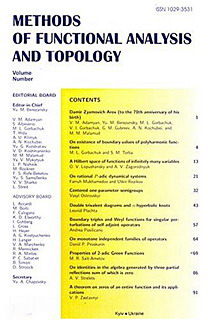C. Y. Lee
Search this author in Google Scholar
The numerical radius points of ${\mathcal L}(^2~ \ell^2_{{({\infty}, \theta)}}: \ell^2_{{({\infty}, \theta)}})$
MFAT 29 (2023), no. 3-4, 101-110
101-110
For $n\geq 2$ and a Banach space $E$ we let
$$
\Pi(E)=\{[x^*, x_1, \ldots, x_n]:
x^{*}(x_j)=\|x^{*}\|=\|x_j\|=1~\mbox{for}~{j=1, \ldots, n}~\},
$$
${\mathcal L}(^n E:E)$ denote the space of all continuous $n$-linear
mappings from $E$ to itself. An element
$[x^*, x_1, \ldots, x_n]\in \Pi(E)$ is called a numerical
radius point of $T\in {\mathcal L}(^n E:E)$ if
$$
|x^{*}(T(x_1, \ldots, x_n))|=v(T),
$$
where $v(T)$ is the numerical radius of $T$. By
$\rm{Nradius}({T})$ we denote the set of all numerical
radius points of $T$.
Let $0\leq \theta\leq\frac{\pi}{2}$ and
$\ell^2_{{({\infty}, \theta)}}=\mathbb{R}^2$ with the rotated
supremum norm
$$
\|(x, y)\|_{{({\infty}, \theta)}}=\max\Big\{|x \cos \theta+y \sin
\theta|,~ |x \sin \theta-y \cos \theta|\Big\}.
$$
In this paper, we show that the numerical radius of
$T\in{\mathcal L}(^2~ \ell^2_{{({\infty}, \theta)}}:
\ell^2_{{({\infty}, \theta)}})$ equals to its norm $\|T\|.$ Using
this, we classify $\rm{Nradius}({T})$ for every
$T\in {\mathcal L}(^2~ \ell^2_{{({\infty}, \theta)}}:
\ell^2_{{({\infty}, \theta)}})$ in connection with the norming
points of the bilinear mapping associated with $T$. Let
$$
\mbox{NA}({\mathcal L}(^n E:E))=\{T\in {\mathcal L}(^n E:E):
T~\mbox{is norm attaining} \}
$$
and
$$
\mbox{NRA}({\mathcal L}(^n E:E))=\{T\in {\mathcal L}(^n E:E):
T~\mbox{is numerical radius attaining} \}.
$$
We also show that
$ \mbox{NA}({\mathcal L}(^2~ \ell^2_{{({\infty}, \theta)}}:
\ell^2_{{({\infty}, \theta)}}))=\mbox{NRA}({\mathcal L}(^2~
\ell^2_{{({\infty}, \theta)}}: \ell^2_{{({\infty}, \theta)}})),$
which generalizes some results in [12].
Для $n\geq 2$ і банахова простору $E$ покладемо
$$
\Pi(E)=\{[x^*, x_1, \ldots, x_n]:
x^{*}(x_j)=\|x^{*}\|=\|x_j\|=1~\mbox{для}~{j=1, \ldots, n}~\},
$$
де ${\mathcal L}(^n E:E)$ позначає простір усіх неперервних
$n$-лінійних відображень $E$ на себе. Елемент
$[x^*, x_1, \ldots, x_n]\in \Pi(E)$ називається точкою чисельного
радіусу $T\in {\mathcal L}(^n E:E)$, якщо
$$
|x^{*}(T(x_1, \ldots, x_n))|=v(T),
$$
де $v(T)$ — чисельний радіус $T$. За $\rm{Nradius}({T})$
позначимо множину всіх точок чисельного радіусу $T$.
Нехай $0\leq \theta\leq\frac{\pi}{2}$ і
$\ell^2_{{({\infty}, \theta)}}=\mathbb{R}^2$ із поверненою
супремум нормою
$$
\|(x, y)\|_{{({\infty}, \theta)}}=\max\Big\{|x \cos \theta+y \sin
\theta|,~ |x \sin \theta-y \cos \theta|\Big\}.
$$
Показано, що чисельний радіус
$T\in{\mathcal L}(^2~ \ell^2_{{({\infty}, \theta)}}:
\ell^2_{{({\infty}, \theta)}})$ дорівнює своїй нормі $\|T\|.$
Використовуючи це, ми класифікуємо $\rm{Nradius}({T})$
для кожного
$T\in {\mathcal L}(^2~ \ell^2_{{({\infty}, \theta)}}:
\ell^2_{{({\infty}, \theta)}})$, пов'язуючи з нормуючими точками
білінійного відображення, відповідного $T$. Нехай
$$
\mbox{NA}({\mathcal L}(^n E:E))=\{T\in {\mathcal L}(^n E:E):
T~\mbox{досягає норми} \}
$$
і
$$
\mbox{NRA}({\mathcal L}(^n E:E))=\{T\in {\mathcal L}(^n E:E):
T~\mbox{досягає чисельного радіусу} \} .
$$
Ми також показуємо що
$ \mbox{NA}({\mathcal L}(^2~ \ell^2_{{({\infty}, \theta)}}:
\ell^2_{{({\infty}, \theta)}}))=\mbox{NRA}({\mathcal L}(^2~
\ell^2_{{({\infty}, \theta)}}: \ell^2_{{({\infty}, \theta)}})),$ що
узагальнює деякі результати роботи [12].
Smooth bilinear forms of ${\mathcal L}(^2\mathbb{R}_{h(w_1, w_2)}^2)$ and ${\mathcal L}(^2\mathbb{R}_{h^{'}(w_1, w_2)}^2)$
MFAT 29 (2023), no. 1-2, 39-56
39-56
We characterize smooth points of unit balls in some spaces of
bilinear forms on $\mathbb{R}^2$. We find that for some special
cases of hexagonal norms, the set of smooth points of the unit ball
of symmetric bilinear forms coincides with the set of those smooth
points of the unit ball of bilinear forms that are symmetric.
Надано характеристику гладким точкам одиничних куль в
деяких просторах білінійних форм на $ \mathbb {R}^2$. Знайдено,
що для деяких частинних випадків гексагональних норм множина
гладких точок одиничної кулі співпадає з множиною тих гладких точок
одиничної кулі білінійних форм, які є симетричними.

